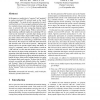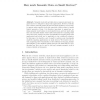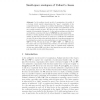4217 search results - page 4 / 844 » The Small Model Property: How Small Can It Be |
IJON
2007
13 years 7 months ago
2007
Despite a steady improvement of computational hardware, results of numerical simulation are still tightly bound to the simulation tool and strategy used, and may substantially var...
IWQOS
2004
Springer
14 years 1 months ago
2004
Springer
In this paper, we consider how to “construct” and “maintain” an overlay structured P2P network based on the “smallworld paradigm”. Two main attractive properties of a ...
ICADL
2010
Springer
13 years 9 months ago
2010
Springer
Can the speakers of small languages, which may be remote, unwritten, and endangered, be trained to create an archival record of their oral literature, with only limited external su...
EKAW
2010
Springer
13 years 6 months ago
2010
Springer
Abstract. Semantic tools such as triple stores, reasoners and query engines tend to be designed for large-scale applications. However, with the rise of sensor networks, smart-phone...
FCT
2009
Springer
14 years 2 months ago
2009
Springer
In the uniform circuit model of computation, the width of a boolean circuit exactly characterises the “space” complexity of the computed function. Looking for a similar relatio...



